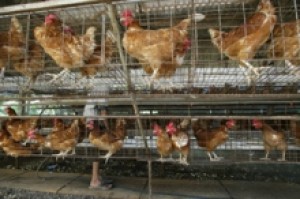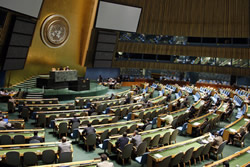Bird Flu rears its head again.
Bird Flu rears its head again
Increased preparedness and surveillance urged against variant strain
 Rome – FAO today urged heightened readiness and surveillance against a possible major resurgence of the H5N1 Highly Pathogenic Avian Influenza amid signs that a mutant strain of the deadly Bird Flu virus is spreading in Asia and beyond, with unpredictable risks to human health.
Rome – FAO today urged heightened readiness and surveillance against a possible major resurgence of the H5N1 Highly Pathogenic Avian Influenza amid signs that a mutant strain of the deadly Bird Flu virus is spreading in Asia and beyond, with unpredictable risks to human health.
The H5N1 virus has infected 565 people since it first appeared in 2003, killing 331 of them, according to WHO figures. The latest death occurred earlier this month in Cambodia, which has registered eight cases of human infection this year — all of them fatal.
Since 2003 H5N1 has killed or forced the culling of more than 400 million domestic poultry and caused an estimated $20 billion of economic damage across the globe before it was eliminated from most of the 63 countries infected at its peak in 2006.
However, the virus remained endemic in six nations, although the number of outbreaks in domestic poultry and wild bird populations shrank steadily from an annual peak of 4000 to just 302 in mid 2008. But outbreaks have risen progressively since, with almost 800 cases recorded in 2010-2011.
Virus spread in both poultry and wild birds
At the same time, 2008 marked the beginning of renewed geographic expansion of the H5N1 virus both in poultry and wild birds.
The advance appears to be associated with migratory bird movements, according to FAO Chief Veterinary Officer Juan Lubroth. He said migrations help the virus travel over long distances, so that H5N1 has in the past 24 months shown up in poultry or wild birds in countries that had been virus-free for several years.
“Wild birds may introduce the virus, but peoples’ actions in poultry production and marketing spread it,” Lubroth noted.
Recently affected areas are to be found in Israel and the Palestinian Territories, Bulgaria, Romania, Nepal and Mongolia.
A further cause for concern, Lubroth said, is the appearance in China and Viet Nam of a variant virus apparently able to sidestep the defences provided by existing vaccines.
In Viet Nam, which suspended its springtime poultry vaccination campaign this year, most of the northern and central parts of the country — where H5N1 is endemic — have been invaded by the new virus strain, known as H5N1 – 2.3.2.1.
High alert
Viet Nam’s veterinary services are on high alert and reportedly considering a novel, targeted vaccination campaign this fall. Virus circulation in Viet Nam poses a direct threat to Cambodia, Thailand and Malaysia as well as endangering the Korean peninsula and Japan further afield. Wild bird migration can also spread the virus to other continents.
“The general departure from the progressive decline observed in 2004-2008 could mean that there will be a flareup of H5N1 this fall and winter, with people unexpectedly finding the virus in their backyard,” Lubroth said.
The countries where H5N1 is still firmly entrenched – Bangladesh, China, Egypt, India, Indonesia and Vietnam – are likely to face the biggest problems but no country can consider itself safe, he said.
“Preparedness and surveillance remain essential,” Lubroth underlined. “This is no time for complacency. No one can let their guard down with H5N1.”
###
> UN Food and Agriculture Organization (FAO).
The Food and Agriculture Organization of the United Nations (FAO) is an intergovernmental organization and has 191 Member Nations, two associate members and one member organization, the European Union. Achieving food security for all is at the heart of FAO’s efforts – to make sure people have regular access to enough high-quality food to lead active, healthy lives.

FAO’s mandate is to raise levels of nutrition, improve agricultural productivity, better the lives of rural populations and contribute to the growth of the world economy.
The Food and Agriculture Organization of the United Nations (FAO) is working with its Members and the entire international community for achievement of the Millennium Development Goals.
These eight goals – each with specific targets and indicators – are based on the United Nations Millennium Declaration, signed by world leaders in September 2000. They commit the international community to combating poverty, hunger, disease, illiteracy, environmental degradation, and discrimination against women.
![]()
The eight Millennium Development Goals are:
Goal 1: Eradicate extreme poverty and hunger
Goal 2: Achieve universal primary education
Goal 3: Promote gender equality and empower women
Goal 4: Reduce child mortality
Goal 5: Improve maternal health
Goal 6: Combat HIV/AIDS, malaria and other diseases
Goal 7: Ensure environmental sustainability
Goal 8: Develop a Global Partnership for Development
* More information at UN Food and Agriculture Organization (FAO)
###
> United Nations (UN).
 The United Nations was established on 24 October 1945 by 51 countries committed to preserving peace through international cooperation and collective security. Today, nearly every nation in the world belongs to the UN: membership totals 192 countries.
The United Nations was established on 24 October 1945 by 51 countries committed to preserving peace through international cooperation and collective security. Today, nearly every nation in the world belongs to the UN: membership totals 192 countries.
When States become Members of the United Nations, they agree to accept the obligations of the UN Charter, an international treaty that sets out basic principles of international relations. According to the Charter, the UN has four purposes:
- to maintain international peace and security;
- to develop friendly relations among nations;
- to cooperate in solving international problems and in promoting respect for human rights;
- and to be a centre for harmonizing the actions of nations.
###
* The above story is adapted from materials provided by United Nations (UN)
** More information at United Nations (UN)





















